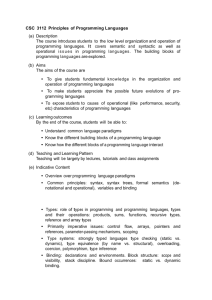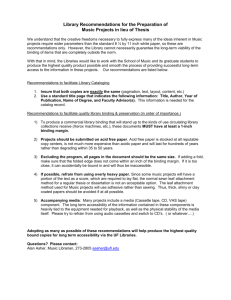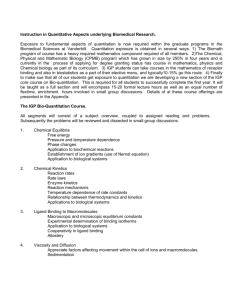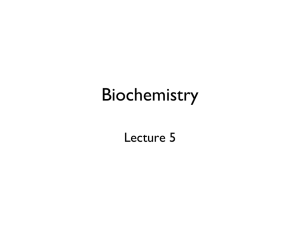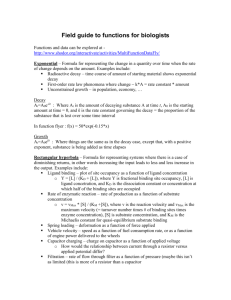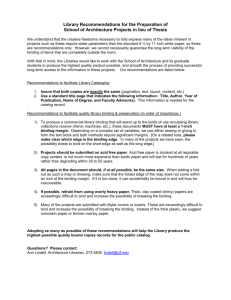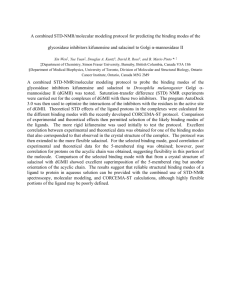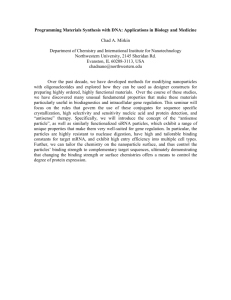Ligand Binding and Allosteric Regulation
advertisement
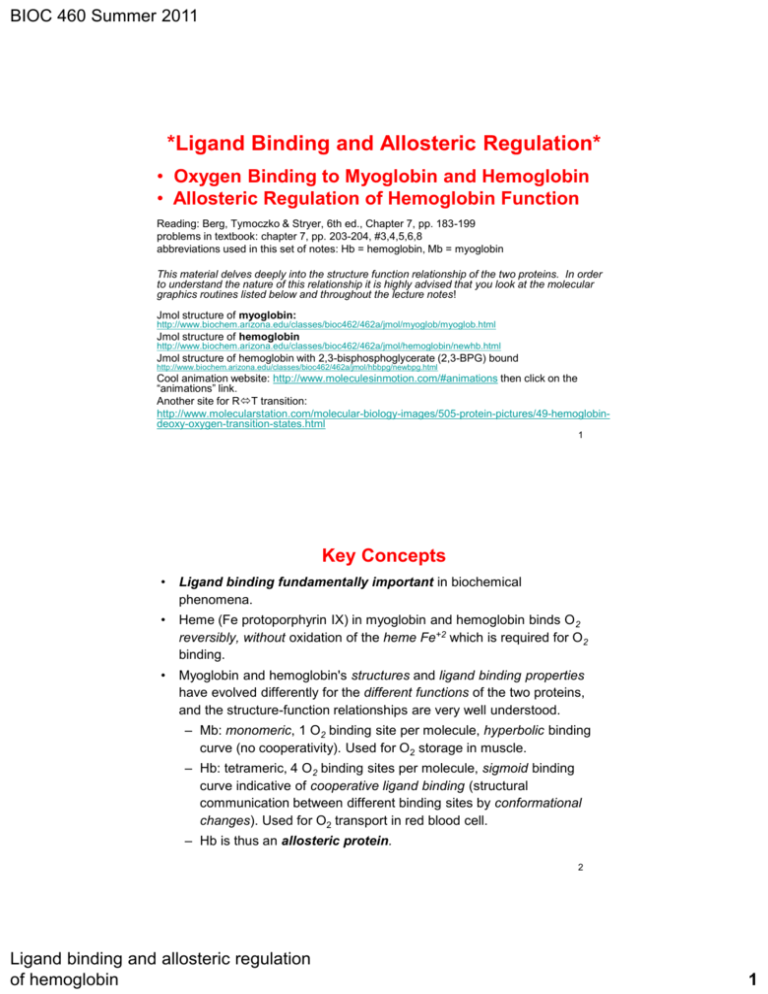
BIOC 460 Summer 2011 *Ligand Binding and Allosteric Regulation* • Oxygen Binding to Myoglobin and Hemoglobin • Allosteric Regulation of Hemoglobin Function Reading: Berg, Tymoczko & Stryer, 6th ed., Chapter 7, pp. 183-199 problems in textbook: chapter 7, pp. 203-204, #3,4,5,6,8 abbreviations used in this set of notes: Hb = hemoglobin, Mb = myoglobin This material delves deeply into the structure function relationship of the two proteins. In order to understand the nature of this relationship it is highly advised that you look at the molecular graphics routines listed below and throughout the lecture notes! Jmol structure of myoglobin: http://www.biochem.arizona.edu/classes/bioc462/462a/jmol/myoglob/myoglob.html Jmol structure of hemoglobin http://www.biochem.arizona.edu/classes/bioc462/462a/jmol/hemoglobin/newhb.html Jmol structure of hemoglobin with 2,3-bisphosphoglycerate (2,3-BPG) bound http://www.biochem.arizona.edu/classes/bioc462/462a/jmol/hbbpg/newbpg.html Cool animation website: http://www.moleculesinmotion.com/#animations then click on the “animations” link. Another site for RT transition: http://www.molecularstation.com/molecular-biology-images/505-protein-pictures/49-hemoglobindeoxy-oxygen-transition-states.html 1 Key Concepts • Ligand binding fundamentally important in biochemical phenomena. • Heme (Fe protoporphyrin IX) in myoglobin and hemoglobin binds O 2 reversibly, without oxidation of the heme Fe+2 which is required for O2 binding. • Myoglobin and hemoglobin's structures and ligand binding properties have evolved differently for the different functions of the two proteins, and the structure-function relationships are very well understood. – Mb: monomeric, 1 O2 binding site per molecule, hyperbolic binding curve (no cooperativity). Used for O2 storage in muscle. – Hb: tetrameric, 4 O2 binding sites per molecule, sigmoid binding curve indicative of cooperative ligand binding (structural communication between different binding sites by conformational changes). Used for O2 transport in red blood cell. – Hb is thus an allosteric protein. 2 Ligand binding and allosteric regulation of hemoglobin 1 BIOC 460 Summer 2011 Key Concepts, continued • • • Hb as an allosteric protein. – R state ("oxy" conformation, high O2 binding affinity) stabilized by O2 binding (O2 is a homotropic effector) – T state ("deoxy" conformation, low O2 binding affinity) stabilized by binding of protons (H+), CO2, and/or 2,3-bisphosphoglycerate (2,3BPG) (all heterotropic effectors, allosteric inhibitors of O2 binding) – Allosteric regulation of O2 binding to Hb is important to enhance the ability of Hb to RELEASE O2 in the tissues. 2,3-BPG is needed in human erythrocytes (red blood cells) to reduce O2 binding affinity enough to get effective release of O 2 in tissues. – 2,3-BPG binds in central cavity of Hb in the T state (stoichiometry 1 BPG/Hb tetramer). Fetal Hb (HbF) has different polypeptide and quaternary structure from adult HbA (Hb F is 22; HbA is 22) – Amino acid differences between and reduces HbF's affinity for 2,3-BPG, thus increasing its affinity for O2 under physiological conditions. 3 Ligand Binding • Terminology: – LIGAND: a molecule or ion (usually small) that's bound by another molecule (usually large, e.g., a protein) – COOPERATIVE ligand binding ("cooperativity"): only observed in proteins containing > 1 binding site AND binding of a ligand (O 2) to 1 binding site affects binding affinities of other binding sites of the same protein molecule. Example: O2 binding to Hb • The essence of protein function/action is BINDING (recognition of and interaction with other molecules). – BINDING: result of specific, usually NONCOVALENT interactions between molecular surfaces • SHAPE complementarity (lots of van der Waals interactions) • CHEMICAL complementarity (hydrogen bonds, salt linkages) • HYDROPHOBIC EFFECT (hydrophobic ligand minimizes exposure to water by binding in hydrophobic site in protein) 4 Ligand binding and allosteric regulation of hemoglobin 2 BIOC 460 Summer 2011 General case: ligand binding to a protein • Ironically, in order to understand ligand BINDING, you usually discuss ligand DISSOCIATION! PL P + L • equilibrium dissociation constant Kd for reaction: • Concentrations of free protein (empty binding sites) = [P], free ligand [L], and PL complex [P•L] in this expression are the equilibrium concentrations. • Note: Kdissociation = 1/ Kassociation; Units of Kd? 5 *FRACTIONAL SATURATION* For: • • Fractional saturation = Y = fraction of total binding sites on protein ([P]total) occupied by ligand Y = [occupied binding sites] / [total binding sites] = Now: AND It can be shown: Note: Kd is a concentration!!!!!!!!!!!!!!! • Plot of fractional saturation (Y) vs. [L] is hyperbolic, with Y approaching a limiting value. 6 Ligand binding and allosteric regulation of hemoglobin 3 BIOC 460 Summer 2011 Fractional Saturation: The SHAPE of this curve suggests you are saturating P with L! Units of Y? Minimum and maximum values of Y? •When Y = 0.5, [L] = Kd •Kd = concentration of free ligand needed to HALF-SATURATE the binding sites Suppose you have 2 proteins that both bind the same ligand, one with Kd = 10–5 M and the other with Kd = 10–7 M. Which one has the higher binding affinity for the ligand? 7 • Kd is a dissociation constant • Kd is the free ligand concentration needed to HALF saturate the protein binding site. • The smaller the value of Kd the tighter the binding (or smaller the amount of dissociation) 8 Ligand binding and allosteric regulation of hemoglobin 4 BIOC 460 Summer 2011 We are now going to study how two proteins with almost exactly the same tertiary structure and same ligand binding site (prosthetic group) behave so fundamentally different that one protein is ideally suited for O2 storage in muscle tissue and the other protein is evolutionarily optimized to bind and transport O2 in a cooperative manner from the lungs to muscle. Structure Function 9 Myoglobin (Mb) http://www.biochem.arizona.edu/classes/bioc462/462a/jmol/myoglob/myoglob.html • • • • • • first high-resolution protein X-Ray crystal structure ever determined (John Kendrew) binds O2 in muscle cells for storage and for intracellular transport, using a heme group mostly (70%) a-helical (8 total, AH); rest mostly turns & loops (at surface) Helices all amphipathic very compact structure (almost no empty space inside) very water-soluble 10 Ligand binding and allosteric regulation of hemoglobin 5 BIOC 460 Summer 2011 Myoglobin structure Berg et al., Fig. 2.48B; heme black with purple Fe2+ Nelson & Cox, Lehninger Principles of Biochemistry, Fig. 4-16 (heme in red; blue residues: Leu, Ile, Val, Phe) 11 O2 binds to heme prosthetic group of Mb (and Hb) • • • Heme: iron protoporphyrin IX, with bound Fe2+ 1 heme per Mb = 1 O2 binding site per Mb molecule 1 heme per Hb subunit, so maximum of 4 O2 can bind to Hb tetramer. 6 coordination positions of heme Berg et al., p.184 Ligand binding and allosteric regulation of hemoglobin Nelson & Cox, Lehninger Principles of Biochemistry, 4th ed., Fig. 5-1 12 6 BIOC 460 Summer 2011 Heme Fe2+ coordination • to 4 N atoms in heme “distal His”, part of E helix (hydrogen bond to distal O atom) • 5th to N of His residue (His F8, "proximal His"). • 6th position: O2 binding site • O2 between Fe2+ and HisE7 (distal) • 2 hydrophobic residues, Val and Phe, help keep Fe2+ from becoming oxidized to Fe3+. Note: O2 ONLY binds to Fe2+!!!!!!!! “proximal His”, part of F helix (attached to heme Fe2+, so if Fe2+ moves, F helix moves) 13 Nelson & Cox, Lehninger Principles of Biochemistry, 4th ed., Fig. 5-5c • • • O2 binding by Myoglobin Myoglobin monomeric (single polypeptide chain) just 1 O2 binding site per molecule (1 heme in each Mb molecule) Mb's O2 binding non-cooperative -- no communication is possible between different binding sites because each site is on a different molecule. • Plot of Y vs. pO2 is hyperbolic. (pO2 is the partial pressure of O2 on a solution. Directly related to [O2] in soln). • P50 is formally equivalent to Kd, the ligand conc. (pO2) when Y =140.5. Ligand binding and allosteric regulation of hemoglobin 7 BIOC 460 Summer 2011 Plot of fractional saturation (Y) vs. pO2 for Mb O2 binding by myoglobin •pO2 (O2 concentration) in pressure units (torr) (Berg et al. Fig. 7-6) •1 torr = 1 mm Hg at 0°C and standard gravity, i.e. sea level. • P50 = ligand (O2) conc. in pressure units that produces Y = 0.5 (50% saturation) • Mb function (O2 storage and transport within cells, like a little molecular "bucket brigade") requires no regulation. ( = P50) Suppose a mutant myoglobin has a P50 of 5 torr. Does the mutant 15 have greater or lesser affinity for O2 than normal Mb (graph)? Hemoglobin, a heterotetramer (a2 2) • http://www.biochem.arizona.edu/classes/bioc462/462a/jmol/hemoglobin/newhb.html • • O2 transport protein very well-understood example of allosteric regulation at a molecular level, related to physiology of whole organism O2 binding to hemoglobin is cooperative. • • 2 identical asubunits (red) structurally similar to 2 identical subunits (yellow) a and also very similar to structure of myoglobin (both primary and tertiary structure) • gene duplication of single ancestral gene and subsequent divergent evolution of sequences --> different globin genes • tertiary "fold" (“globin fold”) conserved through evolution 16 et al., Berg Fig. 2-54 Ligand binding and allosteric regulation of hemoglobin 8 BIOC 460 Summer 2011 Tetrameric Quaternary Structure of Hb: a2 2 = (a)2 • • Hemoglobin's chains spontaneously assemble into quaternary structure. Quaternary structure stabilized by noncovalent bonds (no disulfide bonds in Mb or Hb) • • • Hb structure = a "dimer" of 2 a protomers: (a)2 a + a Each a has one "partner" with which it is more closely associated. Conformational changes in tetramer affect Hb's affinity for O 2. Berg et al. Fig. 7-5 17 Binding of O2 to Hb is sigmoidal, not hyperbolic. • Sigmoid binding curve (Y vs. [ligand]) • Indicates that there are multiple interacting binding sites for ligand on each protein molecule -- the 4 different sites communicate with each other (cooperative binding, allosteric effects). Why does Mb NOT show cooperativity? Berg et al. Fig. 7-7 Ligand binding and allosteric regulation of hemoglobin 18 9 BIOC 460 Summer 2011 Oxygen binding -- Hemoglobin • Allosteric protein (Greek, “allos” = “other”; “stereos” = “shape”) – (def.) Binding of ligand to one site on (multisubunit) protein affects the binding properties of another site on same protein molecule. • sigmoid binding curve, diagnostic of cooperative binding (“cooperativity”) – communication between different ligand binding sites on same multimeric protein molecule – Communication occurs via structural (conformational) changes. – 2 interconvertible conformational states of Hb: low affinity (T) state and high affinity (R) state T R 19 Sigmoid O2 binding curve of Hb -- composite of 2 conformational states • Low affinity curve at low O2 conc. (T state predominating) • High affinity curve at high O2 conc. (R state predominating) T state (low O2 affinity) <==> R state (high O2 affinity) • In absence of O2, equilibrium lies far toward T state (weak O2 binding). • As O2 binds, equilibrium is shifted toward R state (tight binding). O2 binding is a molecular switch that induces a change in O2 binding affinity within a single Hb monomer that is “felt” by the tetrameric protein. Berg et al. Fig. 7-12 20 Ligand binding and allosteric regulation of hemoglobin 10 BIOC 460 Summer 2011 Physiological reason for regulation of O2 binding of Hb • Why would Hb want to regulate the tightness of its O2 binding, such that because of a conformational change, the protein binds O2 with – higher affinity (tighter binding) at higher O2 concentrations – lower affinity (weaker binding) at lower O2 concentrations. • Explanation lies in O2 transport function of Hb. • 2 aspects of transport: a) binding O2 in lungs b) releasing O2 in rest of tissues • Cooperativity enhances O2 delivery/release by Hb. 21 Cooperativity enhances O2 delivery/release by Hb. • Sigmoid curve: Hb is ~ 98% saturated with O2 in the lungs (where pO2 = ~100 torrs). Mb would also be essentially saturated at this pO2 • Difference is clear at lower O2 conc. (20 torr) in tissues , where Mb stays “loaded”, doesn’t unload much O2. • With a sigmoid curve Hb can UNLOAD (release, dissociate) more of its carrying capacity of O2 in the tissues than it could release with non-cooperative binding. 22 Berg et al., Fig. 7-7 Ligand binding and allosteric regulation of hemoglobin 11 BIOC 460 Summer 2011 *Structural basis for cooperativity in Hb* • • • • Very nice animation websites for understanding the structural changes in Hb upon O2 binding: http://www.moleculesinmotion.com/#animations http://www.molecularstationi.com/molecular-biology-images/505-protein-pictures/49-hemoglobin-deoxyoxygen-transition-states.html In absence of bound O2, heme Fe2+ is forced slightly outside porphyrin plane due to ionic radius, coordinated to proximal His residue (His F8). When O2 binds, Fe2+ pulled into plane of heme, pulling with it His F8 residue. (Sterically, this is thermodynamically unfavorable). 23 Tertiary structural changes in T --> R • • Movement of proximal His (F8) toward heme moves F helix. Conformational change of F-helix causes structural changes in interface between a and a protomers, eventually triggering quaternary change in whole Hb tetramer. (OxyHb = red; deoxyHb = gray) 24 Berg et al. Fig. 7-14 Ligand binding and allosteric regulation of hemoglobin 12 BIOC 460 Summer 2011 Quaternary structural changes in T --> R a1 1 • • protomer shifts relative to a2 2 protomer and rotates ~15°. Figure is looking down 2-fold symmetry axis, through central cavity ( subunits yellow). Note decrease in size of central cavity in R state compared to T. Berg et al. Fig. 7-10 (T state) (R state) 25 Animations showing T --> R conformational changes as O2 binds (R state has (red) O2 bound.) • • Overall change (summary): Note change in size of central cavity! Fe2+ moves into plane of heme when O2 binds: http://www.biochem.arizona.edu/classes/bioc462/462a/NOTES/hemoglobin/oxy1.html • Proximal His moves with iron, so F helix moves: http://www.biochem.arizona.edu/classes/bioc462/462a/NOTES/hemoglobin/oxy2.html • Movement of F helix alters tertiary structure of that individual subunit: http://www.biochem.arizona.edu/classes/bioc462/462a/NOTES/hemoglobin/oxy3.html • Tertiary changes in individual subunits cause structural changes in protomer interfaces (between a2 and 1 and between a1 and 2): http://www.biochem.arizona.edu/classes/bioc462/462a/NOTES/hemoglobin/oxy4.html • • When at least 1 O2 has bound to each a protomer (so at least 1 subunit per protomer has changed tertiary conformation), whole quaternary structure shifts: http://www.biochem.arizona.edu/classes/bioc462/462a/NOTES/hemoglobin/oxy5.html A very nice animation website: http://www.moleculesinmotion.com/#animations 26 Ligand binding and allosteric regulation of hemoglobin 13 BIOC 460 Summer 2011 • Any condition that shifts the T R equilibrium toward the R state increases the O2 binding affinity. • Any condition that shifts the T R equilibrium toward the T state decreases the O2 binding affinity. • 3 allosteric inhibitors of O2 binding "tune" the O2 affinity of hemoglobin:Stabilize T state, destabilize R. – 2,3-bisphosphoglycerate (2,3-BPG) – protons (H+) – carbon dioxide (CO2) • Why are allosteric inhibitors of O2 binding needed? • Purified human Hb -- much higher O2 binding affinity than Hb in erythrocytes (red blood cells). • Without some negative allosteric regulator to reduce its affinity for O 2, human Hb wouldn't be able to unload much O2 at all in the tissues. 27 Hb would release only about 8% of its payload at 20 torr! 2,3-bisphosphoglycerate (2,3-BPG) • • • main allosteric inhibitor of O2 binding to human Hb 2,3-BPG = metabolic "byproduct" produced by isomerization of glycolytic intermediate 1,3-BPG in red blood cells highly anionic structure: • derived from glycerol: CH2OH–CHOH–CH2OH • glyceric acid = propionic acid with OH groups on C2 and C3 1 2 3 • C2 and C3 OH groups esterified to phosphates in 2,3-BPG • Where in Hb structure does 2,3-BPG bind? • By what type of interactions? • How does it reduce the O2 binding affinity of Hb? Ligand binding and allosteric regulation of hemoglobin 28 14 BIOC 460 Summer 2011 • 2,3-BPG binds to chain residues in central cavity of Hb tetramer. Jmol structure of BPG-Hb http://www.biochem.arizona.edu/classes/bioc462/462a/jmol/hbbpg/newbpg.html • • • stoichimetry of 2,3-BPG binding = 1 BPG per Hb tetramer. 2,3-BPG does NOT bind where the O2 binds (a heterotrophic effector). 3 + charged groups from each chain in central cavity help bind 2,3BPG by ionic interactions. 29 Berg et al. Fig. 7-16 • • • Central cavity of T state of Hb (the deoxy conformational state) big enough for 2,3-BPG to fit R state has a small central cavity -- not enough room for 2,3-BPG to bind 2,3-BPG binds to T state only, stabilizing T state, and shifting equilibrium toward T (weak O2 binding form), so whole sigmoid O2 binding curve is shifted to higher O2 concentrations (weaker O2 binding, higher P50). like Berg et al., Fig. 7-10 but in ribbon diagram Ligand binding and allosteric regulation of hemoglobin 30 (deoxyHb) (oxyHb) 15 BIOC 460 Summer 2011 Fetal Hemoglobin • • • • During pregnancy O2 taken in by mother through her lungs is transported by maternal adult Hb (a2 2) to placenta for delivery to fetus. In placenta, – maternal (adult) Hb must release O2, and – fetal Hb must bind O2. For effective transfer, fetal Hb must be able to bind O 2 more tightly than maternal Hb. How does fetal Hb manage to bind O2 tighter than maternal Hb? • Different globin genes expressed at different times in embryonic development encoding different Hb subunits, with O2 binding properties tailored to embryo's needs • Last ~2/3 of fetal life: predominant form of Hb present is a2g2. - g chains are being made rather than chains. - vs. g : similar AA sequences, but crucial differences: chains have His 143, in 2,3-BPG binding site. g chains have Ser 143, in 2,3-BPG binding site. What would be the effect of losing a + charged group from BPG binding 31 site, and how would that affect O2 binding affinity? Fetal Hemoglobin, continued • • • A lower fraction of Hb molecules with 2,3-BPG bound means more of fetal Hb is in R state (more than maternal Hb). Thus, under physiological conditions (at conc. of 2,3-BPG found in erythrocytes) fetal Hb has a higher O2 binding affinity than maternal Hb. Thus mother can "deliver" O2 to fetus. O2 affinity of fetal red blood cells • Fetal Hb binds O2 more tightly than maternal (adult) Hb because fetal Hb binds 2,3-BPG less tightly than adult Hb does. Berg et al. Fig. 7-17 Ligand binding and allosteric regulation of hemoglobin 32 16 BIOC 460 Summer 2011 Other negative regulators of O2 binding to Hb: H+ and CO2 • Binding of protons and binding of CO2 promote release of O2 (weaker binding of O2). • Protons and CO2 preferentially bind to the T state of Hb – shift T R equilibrium toward T state – reduce O2 binding affinity of Hb. • Effect of H+ and CO2 (to promote release of O2 from Hb): the "Bohr effect" • Why is it useful physiologically that protons and CO2 bind more tightly to T state than to R state? 33 Physiological role of H+ and CO2 as negative allosteric effectors of O2 binding to hemoglobin • Lungs: (Hb "wants" to bind O2 tightly, to "load up".) – pH is ”high" (pH ~7.4) ([H+] is low) – [CO2] is low because it's being gotten rid of (exhaled) – [O2] is high. – Ligand conc. conditions all favor R state. – Result: O2 binds tightly. (That's what you want, to BIND O2, maximal "loading” in the lungs.) • Tissues: (Hb "wants" to dissociate its O2, to UNLOAD) • pH is “low” (pH ~7.2) ([H+] is high) because catabolism (breakdown of nutrients) produces protons (acid, especially lactic acid in active muscle tissue) • [CO2] is high because CO2 = end product of oxidation of C atoms in catabolism of nutrients. • [O2] is low. • Ligand concentration conditions all favor T state. • Result: O2 binds weakly. (That's what you want, to DISSOCIATE 34 O2, maximal "unloading". Ligand binding and allosteric regulation of hemoglobin 17 BIOC 460 Summer 2011 Effect of pH and of CO2 on O2 binding affinity of Hb (the Bohr effect). • Chemical basis of Bohr effect (at least partially understood): CO2 binds to amino groups of T state. • • Proton concentration: some groups have different pKa values in R state from their pKa values in T state: –higher pKas in T state. Higher pKa in T state means that ionizable group binds protons more tightly in T state than in R state. In the T state, when those groups are protonated, they can form salt links with – charged groups that can’t form in R state. Those salt links stabilize T conformation. • • • Berg et al., Fig. 7-21 35 Mutant human hemoglobins • • • • • Mutant hemoglobins provide unique opportunities to probe structurefunction relations in a protein. There are nearly 500 known mutant hemoglobins and >95% represent single amino acid substitutions. About 5% of the population carries a variant hemoglobin. Some mutant hemoglobins cause serious illness. The structure of hemoglobin is so delicately balanced that small changes can render the mutant protein nonfunctional. 4 types of mutant hemoglobins Properties are altered in one of the following ways: 1. Mutation in heme binding pocket leads to loss of heme. 2. Mutation disrupts tertiary structure of a subunit. 3. Mutation stabilizes methemoglobin (Fe3+ oxidation state of heme in Hb). 4. Mutation stabilizes the R state, or stabilizes the T state, compared to their stabilities in normal HbA. 36 Ligand binding and allosteric regulation of hemoglobin 18 BIOC 460 Summer 2011 4 types of mutant hemoglobins 1. – Mutation in heme binding pocket leads to loss of heme. produces a nonfunctional protein (can't bind O2) 2. Mutation disrupts tertiary structure of a subunit. – produces protein with reduced stability or impaired function or both 3. Mutation stabilizes methemoglobin (Fe3+ oxidation state of heme in Hb). – In order for hemoglobin to reversibly transport O2, iron must remain in ferrous (Fe2+) state. – Oxidizing iron to Fe3+ produces metHb, which does not transport O2. – Red blood cells contains enzymes that can re-reduce the iron in the occasional normal HbA molecule whose iron gets oxidized. – Mutations that stabilize metHb provide a negatively charged oxygen atom as a ligand for the iron, e.g., Glu instead of the normal distal His imidazole N. Negatively charged oxygen ligand stabilizes iron in the Fe3+ state. 37 Mutant hemoglobins, continued 4. Mutation stabilizes the R state, or stabilizes the T state, compared to their stabilities in normal HbA. – Mutations at the subunit interfaces between the two a protomers often interfere with quaternary structure of hemoglobin. – Such mutations can change the relative stabilities of hemoglobin's R and T states, shifting the equilibrium more toward R or more toward T state, thereby affecting O2 affinity of mutant hemoglobin. • Normal HbA has P50 = 26 mm Hg (= 26 torr, or about 3.5 kPa). [P50 is the pO2 at which the fractional saturation = 0.5, so half of Hb's O2 binding sites are occupied.] • For a mutant in which the T-R equilibrium is shifted toward the R state, what type of change would you expect in P50? (Would the P50 for the mutant be higher or lower than normal?) Does that mean O2 affinity of mutant is higher or lower than normal? • For a mutant in which the T-R equilibrium is shifted toward the T state, what type of change would you expect in P50? (Would the P50 for the mutant be higher or lower than normal?) 38 Does that mean O2 affinity of mutant is higher or lower than normal? Ligand binding and allosteric regulation of hemoglobin 19 BIOC 460 Summer 2011 Learning Objectives • Terminology: ligand, fractional saturation, prosthetic group, cooperativity, protomer, binding site, allosteric (allosteric site, allosteric effector, allosteric regulation) Briefly describe the tertiary structure of myoglobin and the hemoglobin subunits (the "globin fold"), explain how the helices are designated, and the roles of the proximal and distal His residues in heme and oxygen binding. Write a general protein-ligand binding/dissociation reaction in both the association and dissociation directions. What is the mathematical relationship between the association and dissociation equilibrium constants? Describe how and where O2 binds in the structure of Mb and Hb, including roles of protein functional groups and heme, and the oxidation state of the heme Fe required for O2 binding. Sketch the O2 binding curve [Y (fractional saturation) vs. pO2] for NONcooperative ligand binding to a protein, such as that for O 2 binding to Mb. On same plot, sketch a binding curve that shows cooperativity (cooperative ligand binding), such as that for O2 binding to hemoglobin, and explain (again) what is meant by cooperativity. On both curves, indicate the value of P50, the pO2 at which fractional saturation of protein with O2 is 0.5. In what part of the cooperative binding curve (what part of the [ligand] concentration range) is protein predominantly in conformation with low ligand binding affinity, and in what part of the ligand concentration range is the predominant form the high binding affinity conformation? 39 • • • • Learning Objectives, continued • • • Explain how hemoglobin works physiologically (in vivo), i.e., how cooperativity in O2 binding to hemoglobin facilitates “loading” of O2 in the lungs and “unloading” of O2 in the tissues. Include the role of the R state (oxy conformation) and the T state (deoxy conformation) of hemoglobin. Briefly describe the structural change that occurs when O 2 binds to the heme of a subunit of hemoglobin, including a) what in the heme structure triggers the protein structural change when O2 binds, b) how that first protein structural change is communicated to other subunits to change the quaternary structure and the O2 binding affinity of the other subunits, and c) effect of the quaternary structural change on size of the central cavity. Explain the effect of 2,3-bisphosphoglycerate on the affinity of mammalian hemoglobin for oxygen, and describe where on the hemoglobin molecule 2,3-BPG binds, how many molecules of 2,3-BPG bind to one hemoglobin tetramer, and predominantly by what type of noncovalent interactions the 2,3-BPG is bound. Does 2,3-BPG bind to the R state or the T state of hemoglobin? 40 Ligand binding and allosteric regulation of hemoglobin 20 BIOC 460 Summer 2011 Learning Objectives, continued • • • • Explain why maternal red blood cells release O2 and fetal red blood cells bind O2 in the placenta in terms of a) the difference in protein primary structure and quaternary structure (subunit composition) between HbA (adult, maternal) and HbF (fetal hemoglobin), b) the effect of the structure of HbF on its 2,3-BPG binding affinity compared to HbA,and c) the resultant difference in O2 binding properties of the 2 hemoglobins and its physiological significance. Discuss the Bohr effect (H+ binding and CO2 binding), in terms of a) the effect of increasing concentrations of either of these ligands on the O2 binding curve for hemoglobin, b) the physiological significance of this phenomenon. For a mutant in which the T-R equilibrium is shifted toward the R state, what type of change would you expect in P50? Does that mean O2 affinity of mutant is higher or lower than normal? Explain similar changes for a mutant in which the T-R equilibrium is shifted toward the T state. 41 Ligand binding and allosteric regulation of hemoglobin 21
